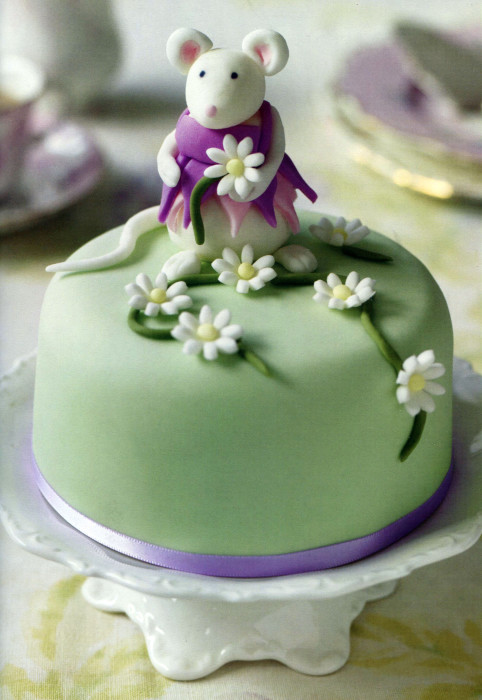Yesterday I posted a review of The Icing on the Cake by Juliet Stallwood. It’s a brilliant book about decorating cakes and cookies with exceptional flavors and figures.
Juliet is a specialist in making complex, and often 3-D decorations. In her book, she describes how to make some of these figures, like that lovely mouse in the picture. The cake is covered in gum paste, while the mouse is made of modeling paste.
What are those things and could you just use fondant instead for everything?
Here’s a link to a full breakdown. Fondant, gum paste, modelilng chocolate, and modeling paste are distinctive products with different uses, pros and cons. If you go to this website, you’ll get a short, but detailed set of information. I will warn you now that cake decorating experts differ on using fondant versus gum paste.
http://www.craftsy.com/article/modeling-chocolate-vs-fondant-vs-gum-paste
Basically, fondant is a gelatin-based product that is great for wrapping a complete cake. Just what you see in the picture above? No, this cake was covered in gum paste instead; it’s a little tricky doing that: the gum paste will dry so this cake needs to be eaten soon. If the cake is going to be consumed a day out, then you definitely want fondant.
Fondant has to be rolled out before applying to the cake, and there are fondant tools to smooth the surface to the perfection you see here. The first time you use fondant, it is not going to look this pretty. Suzen and I speak from personal experience. In fact, fondant is a very sensitive product and there are a number of techniques to master in achieving fondant-perfection.
For example, fondant is subject to changes in temperature and is affected by direct light; the colors can fade and a cake that starts out with one shade of green could end up looking a bit like camouflage at the end of a sunny day’s exposure. Some people have issues with how fondant tastes — and its texture does vary markedly with temperature. Cold out of the fridge fondant is not the same as sitting-on-the-table-two-hours fondant. For a good discussion see:
http://ericaobrien.com/blog/2013/01/ten-things-you-should-know-about-fondant/
Gum paste is made from egg whites, confectioner’s sugar, and shortening. It can be rolled thinner than fondant and is perfect for shaping little things, like a mouse’s legs and arms. Gum paste will dry, unlike fondant which will stay soft, so it is perfect for figures that have to retain their shape — even when there is gravity tugging away. There is a general warning that because it dries hard, can become brittle, and can then crack, you don’t want to cover a cake with gum paste — I know, that beauty in green gum paste above looks fine. Like I said, pastry chefs differ.
Gum paste is edible, but many people do not appreciate the taste.
Modeling chocolate is made with melted chocolate and corn or simple syrup. The liquid is kneaded until it becomes clay-like and ready to mold. You mold figures and wrap an entire cakes in modeling chocolate. To learn how, look at Cake Decorating with Modeling Chocolate by Kristen Coniaris.
There is also something called modeling paste which in America has two meanings. The first thing that comes up on google is a substance made from glue, like Elmer’s glue. You don’t want to use that on a cake.
On the other hand, in The Icing on the Cake, Juliet discusses what in Britain is called modeling paste. It’s totally different. You add CMC [ sodium carboxymethylcellulose] to regular gum paste, then use it like gum paste. It takes longer to dry than pure gum paste, but it dries much, much harder. If you don’t want to buy your own sodium carboxymethylcellulose, you can skip the do‑it‑yourself step and go to Amazon or visit a craft store that has Wilton products for the safe, edible versions.
So, if you are reading a recipe for cake decoration, just be sure of what it says and what you think it says. Think about your timeline for when the cake will be eaten. And consider storage time, time to bring the cake to a decent eating temperature, and protecting it from harsh light.
This is why there are professional cake bakers for parties.

